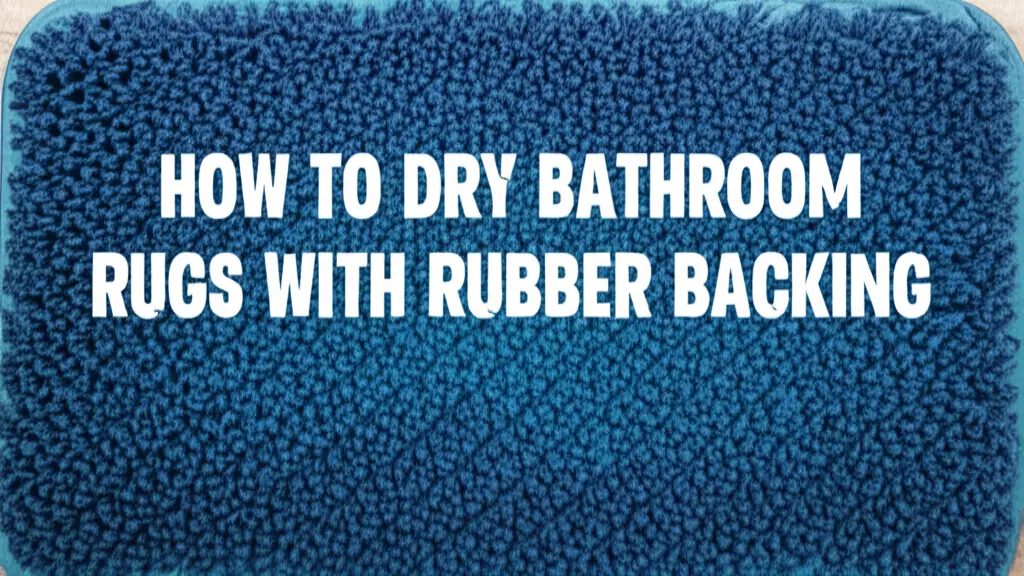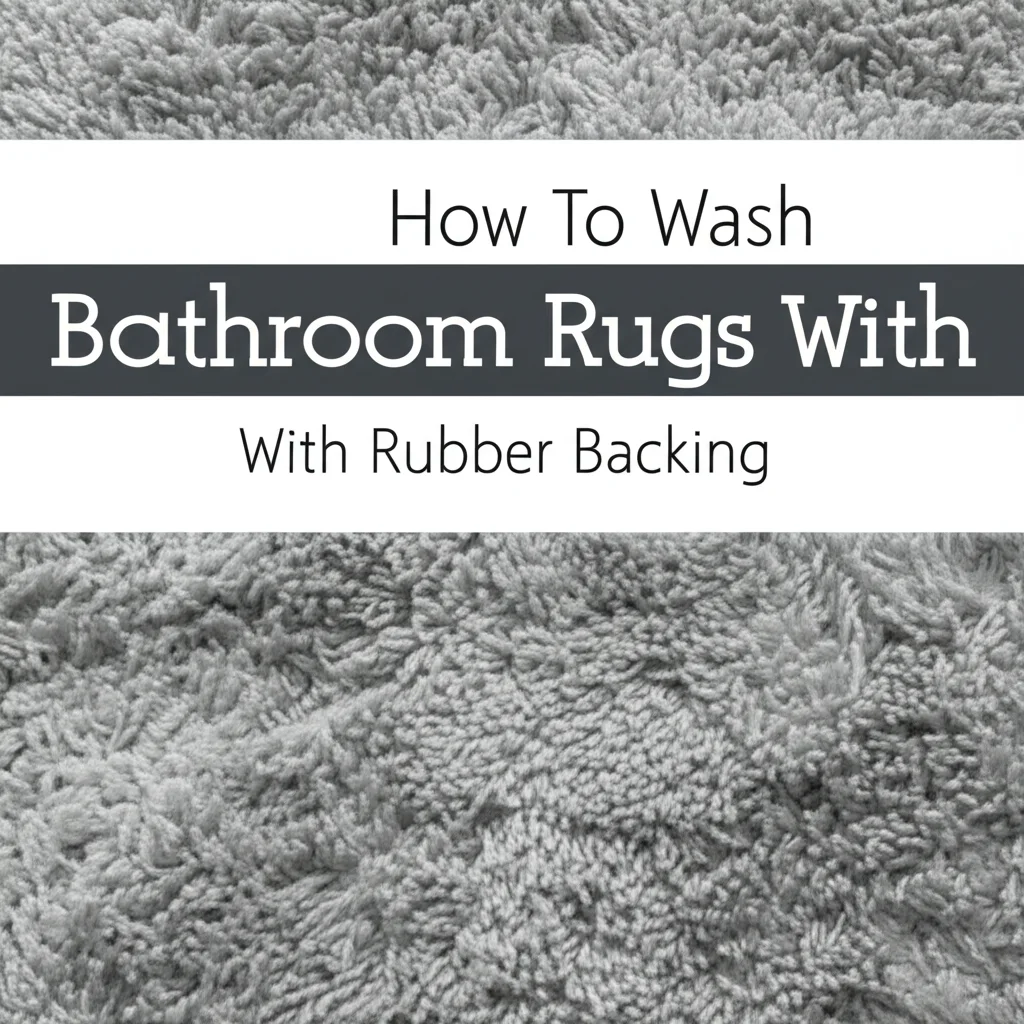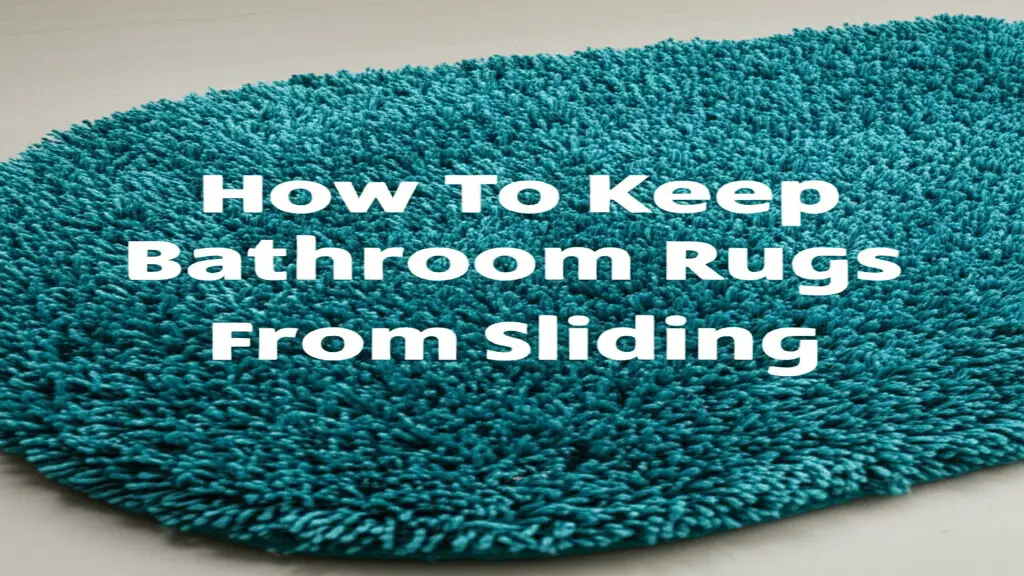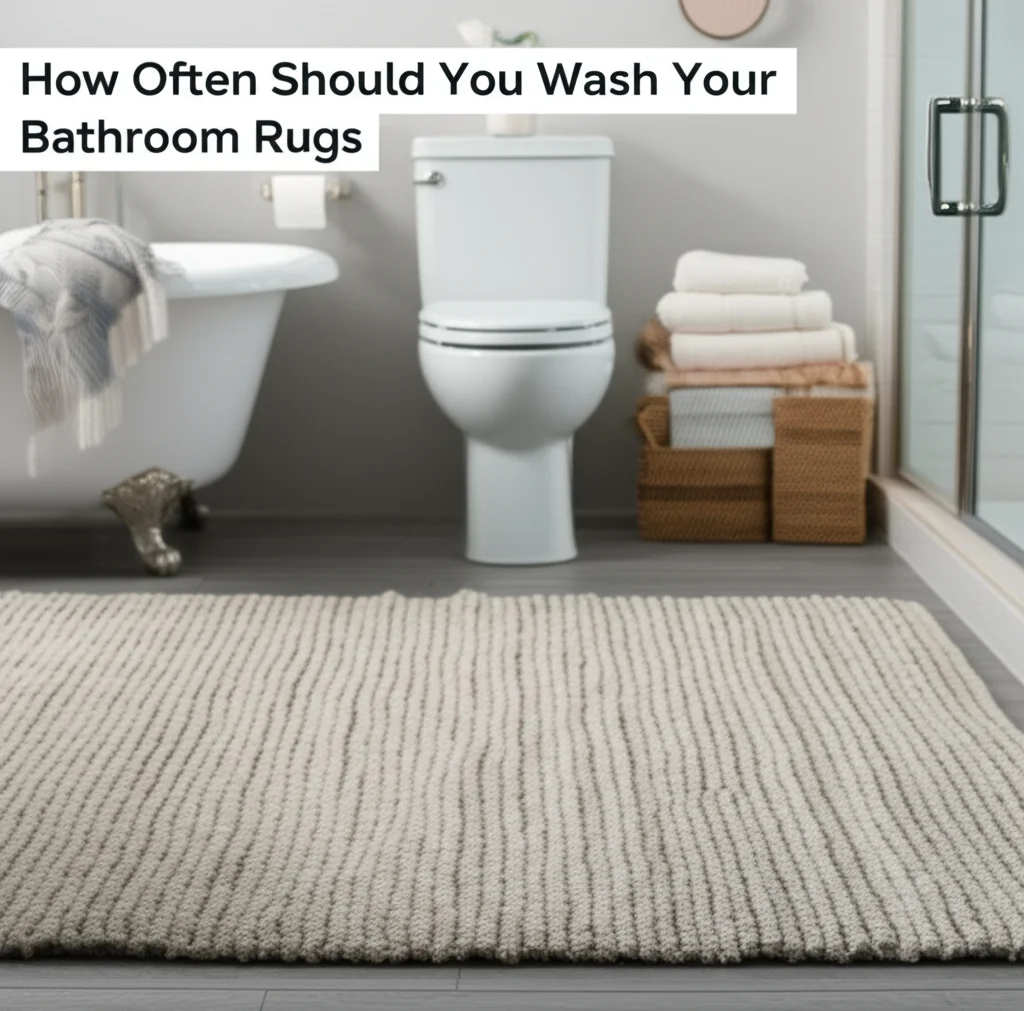· Todd Martin · Bathroom Cleaning · 13 min read
How To Dry Bathroom Rugs With Rubber Backing

Quick Takeaway
- Air drying is the safest method for rubber-backed bathroom rugs
- Use low heat settings if using a dryer
- Never use high heat as it damages rubber backing
- Proper drying techniques extend rug lifespan by years
- Regular cleaning prevents mold and mildew growth
Want to keep your bathroom rugs with rubber backing in perfect condition for longer? The key is proper drying. Bathroom rugs with rubber backing require special care when drying to prevent damage and maintain their slip-resistant properties. This comprehensive guide walks you through various effective methods to dry your bathroom rugs safely.
Why Proper Drying Matters for Rubber-Backed Bathroom Rugs
Bathroom rugs with rubber backing are popular for a reason—they provide safety by preventing slips and falls on wet bathroom floors. However, their convenience comes with a maintenance challenge: the rubber backing is sensitive to heat and improper drying methods.
When exposed to excessive heat, the rubber backing can deteriorate quickly, leading to cracking, peeling, and crumbling. This not only creates a mess but also compromises the rug’s primary safety function. Additionally, improper drying can lead to mold and mildew growth, especially since bathroom rugs are constantly exposed to moisture.
Proper drying techniques extend the lifespan of your bathroom rugs significantly—potentially adding years to their useful life. With the right approach, you can maintain both the appearance of the fabric and the integrity of the rubber backing.
Before diving into drying methods, it’s important to note that proper washing is the first step toward effective drying. Always check the care label on your specific rug for manufacturer recommendations, as these can vary based on materials and construction.
Air Drying: The Safest Method for Rubber-Backed Rugs
Air drying is universally recognized as the safest method for drying bathroom rugs with rubber backing. This gentle approach preserves the rubber backing by avoiding heat exposure altogether.
How to Air Dry Effectively:
Shake excess water: After washing, gently shake the rug to remove as much water as possible.
Press with towels: Lay the rug flat on a dry bath towel with the rubber side up. Place another towel on top and press down to absorb moisture. You can also roll the rug in towels and press gently to extract water.
Select an appropriate drying location: Choose a well-ventilated area with good air circulation. Avoid direct sunlight as it can degrade the rubber backing over time.
Position for maximum airflow: Hang the rug over a shower rod, drying rack, or clothesline with the rubber side facing outward. Ensure the rug isn’t folded, as this can trap moisture and extend drying time.
Flip periodically: Turn the rug every few hours to ensure even drying on both sides.
Air drying typically takes 24-48 hours, depending on humidity levels and air circulation in your home. While this method requires patience, it’s worth the wait to preserve your rug’s quality and longevity.
For those living in humid climates, using a dehumidifier or fan in the drying area can significantly reduce drying time while still avoiding heat damage.
Using a Dryer Safely for Rubber-Backed Bathroom Rugs
While air drying is preferable, sometimes time constraints necessitate using a dryer. If you must use a machine, follow these guidelines to minimize potential damage:
Safe Dryer Usage Tips:
Use the lowest heat setting: Select “air fluff,” “air dry,” or “no heat” cycles whenever possible. Low heat is the absolute maximum you should use, and even then, only for brief periods.
Add dry towels: Place clean, dry towels in the dryer along with your bathroom rug to help absorb moisture and reduce drying time.
Use short cycles: Instead of one long drying cycle, opt for multiple short cycles (10-15 minutes each), checking the rug between cycles. This prevents overheating of the rubber backing.
Add dryer balls or clean tennis balls: These create more airflow around the rug and prevent it from clumping, allowing for more efficient drying.
Remove promptly: As soon as the rug is dry, remove it from the dryer to prevent unnecessary heat exposure.
Check frequently: Monitor the temperature inside the dryer by touching the rug periodically. If it feels hot to the touch, the setting is too high.
Even with these precautions, you should be aware that repeated machine drying will gradually degrade the rubber backing over time. Consider alternating between machine drying and air drying to extend your rug’s lifespan.
Many Reddit users have shared that they successfully dry their rubber-backed rugs on low or no heat, but almost universally note that the rubber backing deteriorates much faster with frequent machine drying.
Quick-Drying Methods for When You’re in a Hurry
Sometimes you need your bathroom rug dry quickly, whether for guests arriving or simply because it’s your only bathroom mat. Here are effective methods to speed up the drying process without compromising the rubber backing:
Expedited Drying Techniques:
Use a spin cycle: If your washing machine has a high-speed spin cycle, use it to extract maximum water before removing the rug. This simple step significantly reduces drying time.
Employ a wet/dry vacuum: Run a wet/dry vacuum over both sides of the rug to extract excess moisture. This can reduce drying time by hours.
Set up fans strategically: Position one or two fans to blow directly across the rug to increase air circulation dramatically. Angle the fans for maximum airflow across both sides.
Utilize a dehumidifier: Place a dehumidifier in the room where you’re drying the rug to pull moisture from the air, creating a more favorable drying environment.
Bathroom ventilation: If drying in the bathroom, turn on the exhaust fan to help remove humid air.
Hair dryer technique: For spot drying or small rugs, use a hair dryer on the cool setting, keeping it at least 6 inches away from the rug and moving it constantly to avoid concentrating heat in one area.
By combining several of these methods, you can significantly reduce drying time while still protecting the integrity of the rubber backing. For example, using the spin cycle followed by towel-pressing and then fan-drying can reduce typical air-drying time from 24+ hours to just 6-8 hours.
Remember that how you wash your bathroom rugs directly impacts drying time as well. Using less detergent and including a second rinse cycle prevents soap buildup that can retain moisture and extend drying time.
Common Mistakes to Avoid When Drying Rubber-Backed Rugs
Many well-intentioned cleaning routines can accidentally damage rubber-backed rugs. Avoid these common pitfalls to maximize the lifespan of your bathroom rugs:
Drying Mistakes That Damage Rubber Backing:
Using high heat: This is the number one enemy of rubber backing, causing it to melt, crack, or disintegrate. Never use medium or high heat settings on your dryer.
Direct sunlight exposure: While sunlight seems like a natural drying choice, UV rays break down rubber over time, leading to premature deterioration. If using sunshine to dry, place the rug in partial shade with the rubber backing away from direct sun.
Hanging by corners: This stretches both the fabric and the rubber backing unevenly. Always lay flat or hang evenly distributed over a rod or line.
Using fabric softeners: These products leave a residue that can degrade rubber backing and reduce the rug’s absorbency. Skip the fabric softener during washing to improve drying efficiency.
Folding while damp: Storing or folding a rubber-backed rug before it’s completely dry creates ideal conditions for mold and mildew growth.
Ironing or steaming: Never attempt to speed dry using an iron or steamer, as direct heat will instantly damage the rubber backing.
Overloading the dryer: This prevents proper air circulation and can lead to uneven drying and overheating in some areas.
By avoiding these common mistakes, you’ll extend the functional life of your bathroom rugs considerably, saving money and reducing waste. Remember that proper cleaning techniques work hand-in-hand with proper drying to maintain your rugs.
Specialized Solutions for Different Types of Rubber-Backed Rugs
Not all bathroom rugs with rubber backing are created equal. Different materials and constructions may require slight variations in drying approaches:
Material-Specific Drying Guidelines:
Cotton Rugs with Rubber Backing
- More absorbent and typically take longer to dry
- Benefit greatly from an extra spin cycle before drying
- More prone to shrinkage if exposed to heat
- Ideal for the towel-pressing method to extract moisture
Microfiber Rugs with Rubber Backing
- Dry relatively quickly compared to cotton
- Less likely to shrink when exposed to low heat
- Can usually withstand brief dryer cycles better than cotton
- Still vulnerable to rubber backing damage from excessive heat
Memory Foam Rugs with Rubber Backing
- Require special care as both the memory foam and rubber backing are heat-sensitive
- Should never be machine dried, even on low heat
- Best dried completely flat to maintain foam structure
- Can be gently pressed with towels but never wrung out
Extra-Large Bathroom Rugs
- May need to be repositioned periodically during air drying
- Consider hanging over a shower curtain rod at the midpoint
- May benefit from fan-assisted drying from both sides
- Take significantly longer to dry; plan for 48+ hours of air drying
Understanding your specific type of rug allows you to adapt these general principles for optimal results. When in doubt, check the manufacturer’s care instructions or opt for the gentlest drying method available.
For specialized rugs like large rubber-backed area rugs, you may need to consider professional cleaning services that have appropriate equipment for proper drying.
How to Tell When Your Rubber-Backed Rug Is Completely Dry
Ensuring your bathroom rug is thoroughly dry before returning it to service is crucial for preventing mold and mildew growth. Here’s how to be certain your rug is ready to use:
Signs Your Rug Is Completely Dry:
Touch test: Press your hand firmly against various parts of the rug, including the middle and corners. If you feel any coolness or dampness, it needs more drying time.
Weight assessment: A completely dry rug will feel noticeably lighter than a damp one. If it still feels heavy, continue drying.
Smell check: Damp rugs often have a distinct musty odor. If you detect any mustiness, the rug needs more drying time.
Visual inspection: Look for any darker areas on the fabric side, which may indicate remaining moisture. The colors should be uniform throughout.
Rubber backing test: The rubber backing should feel completely dry and room temperature to the touch. Any tacky feeling suggests it’s still damp.
Remember that the rubber backing often takes longer to dry than the fabric portion. You might think the rug is dry based on the fabric side, only to find the rubber backing is still retaining moisture. Always check both sides thoroughly.
As a general guideline, add an extra 2-4 hours of drying time after you think the rug might be dry, particularly if you plan to place it on hardwood floors where trapped moisture could cause damage.
Creating a Sustainable Bathroom Rug Care Routine
To maximize the lifespan of your rubber-backed bathroom rugs while maintaining a clean bathroom environment, establish a regular care routine:
Sustainable Care Practices:
Rotate multiple rugs: If possible, maintain 2-3 bathroom rugs that you can rotate. This gives each rug ample time to dry completely between uses.
Preventative maintenance: Hang your bathroom rug over a towel bar or shower rod between uses to allow it to dry out, reducing how often you need to wash it.
Scheduled cleaning: Rather than waiting until rugs look visibly soiled, establish a regular cleaning schedule. Most bathroom rugs should be washed every 1-2 weeks, depending on household size and usage.
Invest in quality: Higher-quality bathroom rugs with superior rubber backing typically withstand more wash and dry cycles before deteriorating. The initial higher cost often results in better long-term value.
Consider alternatives: For areas where rugs frequently get soaked, consider wooden bath mats or quick-drying materials that require less intensive care.
Proper storage: When storing bathroom rugs for extended periods, ensure they are completely clean and thoroughly dry, then roll rather than fold them to preserve the rubber backing.
By implementing these practices, you’ll not only extend the life of your current bathroom rugs but also reduce the environmental impact of frequently replacing damaged rugs. Knowing how often to wash your bathroom rugs is key to a balanced care routine.
Frequently Asked Questions
Can you dry bath mats with rubber backing?
Yes, you can dry bath mats with rubber backing, but you must use appropriate methods. Air drying is safest, but if using a dryer, only use no-heat or low-heat settings for short periods. Always check the care label for specific manufacturer recommendations, as some rugs should never be machine dried.
Can rubber backed rugs be dried in a dryer?
Rubber backed rugs can be dried in a dryer, but only with extreme caution. Use only air-dry or low-heat settings, include dry towels to absorb moisture, and limit drying to short 10-15 minute cycles. Check the rug frequently and remove it as soon as it’s dry to prevent damage to the rubber backing.
How do you clean bathroom rugs with rubber backing?
To clean bathroom rugs with rubber backing, machine wash in cold water with mild detergent on a gentle cycle. Avoid bleach and fabric softeners as they damage the rubber. For heavily soiled rugs, pre-treat stains before washing. After washing, shake off excess water before proceeding with appropriate drying methods.
How do you hang a rubber bath mat to dry?
To hang a rubber bath mat to dry, drape it evenly over a shower curtain rod, towel bar, or drying rack with the rubber side facing outward. Ensure it’s hung without folds or creases that could trap moisture. For larger mats, hang them at the midpoint to distribute weight evenly and prevent stretching.
How long do bath mats take to air dry?
Bath mats typically take 24-48 hours to air dry completely, depending on humidity levels, air circulation, and the mat’s thickness. Cotton rugs take longer than synthetic materials. Using fans or dehumidifiers can reduce drying time significantly. Always ensure the rubber backing is completely dry before using or storing the mat.
Can you put rubber-backed bathroom rugs in the washing machine?
Yes, rubber-backed bathroom rugs can typically be washed in a washing machine using cold water and mild detergent on a gentle cycle. However, avoid overloading the machine, which can damage both the rug and the washer. Some extra-large rugs may require commercial machines or handwashing.
How do I stop my rubber-backed bath mat from shedding?
To prevent a rubber-backed bath mat from shedding rubber particles, always air dry or use no-heat dryer settings, avoid harsh detergents when washing, and don’t use fabric softeners or bleach. Freezing rubber backing for 20 minutes before gentle brushing can sometimes help remove loose particles without causing further damage.
Final Words
Proper care and drying of bathroom rugs with rubber backing doesn’t have to be complicated. By following the guidelines in this comprehensive guide, you can significantly extend the life of your bathroom rugs while maintaining their appearance and functionality. Remember that taking a little extra time to dry your rugs properly today will save you the expense and inconvenience of frequent replacements.
Whether you choose to air dry, use low-heat dryer settings, or employ quick-drying techniques, the key is to protect the rubber backing from excessive heat and ensure thorough drying before reuse. Establishing a regular care routine that includes appropriate drying methods will keep your bathroom rugs looking fresh and performing safely for years to come.
Ready to improve your bathroom rug care routine? Start by implementing these drying techniques today, and you’ll quickly notice the difference in your rugs’ longevity and performance.





